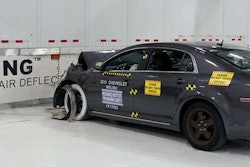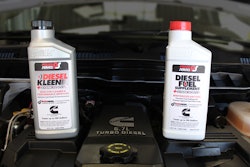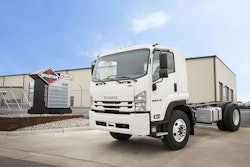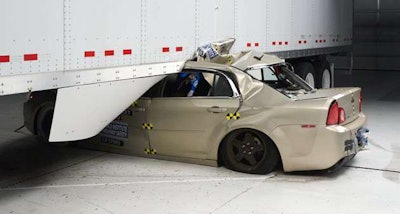
Testing conducted by the Insurance Institute for Highway Safety (IIHS) this spring shows underride guards mounted to the side of a trailer provide similar safety benefits as rear-mounted guards.
Earlier this year, IIHS conducted two 35-mph crash tests: one with an AngelWing side underride protection device from Airflow Deflector Inc., and a second test with a fiberglass side skirt intended to improve aerodynamics but not designed to prevent underride. Tests conducted this spring marked the first time that IIHS has evaluated a side underride guard.
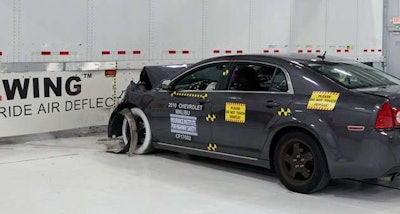 In the AngelWing test, IIHS says underride guard bent but kept the car from going underneath the trailer.
In the AngelWing test, IIHS says underride guard bent but kept the car from going underneath the trailer.In both tests, a midsize passenger car struck the center of a 53-foot dry van trailer. In the AngelWing test, IIHS says underride guard bent but kept the car from going underneath the trailer. In the second test with no underride guard protection, the impact sheared off part of the roof and the sedan wedged itself beneath the trailer. IIHS says the car’s occupants in a collision similar to the second test would likely suffer fatal injuries.
“Our tests and research show that side underride guards have the potential to save lives,” says David Zuby, the Institute’s executive vice president and chief research officer. “We think a mandate for side underride guards on large trucks has merit, especially as crash deaths continue to rise on our roads.”
In 2015, IIHS says 301 of the 1,542 passenger vehicle occupants killed in two-vehicle crashes with a tractor-trailer died when their vehicles struck the side of a tractor-trailer, compared to 292 people who died when their passenger vehicles struck the rear of a tractor-trailer. Federal law mandates that large trucks have rear underride guards but does not require side guards.
A 2012 IIHS study found that rigid side underride guards could reduce injury risk in about 75 percent of all large truck side crashes producing a fatality or serious injury to a passenger vehicle occupant. This proportion increased to almost 90 percent when restricted to crashes with semitrailers.
However, the American Trucking Associations notes that while side underride may improve safety, overall crash protection has several complicating factors – like engineering tradeoffs involving weight, strength, and effectiveness – that have prevented a consensus around adopting side underride guards.
“For example, side underride guards would add significant weight and require stiffer trailers which can develop cracks in the frame rails during normal operation – wearing out sooner and creating a safety issue of potential trailer failure during operation,” the organization said through a statement provided to CCJ Thursday.
Because of gaps in federal crash data, IIHS researchers can’t determine exactly how many of these crashes involve underride, but the agency estimates underride occurs in about half of fatal crashes between large trucks and passenger vehicles.
“ATA believes the best way to prevent underride deaths is to prevent crashes in the first place, which is why our industry invests more than $9 billion in safety initiatives,” the trucking agency says. “Wider deployment of advanced vehicle safety technologies like automatic emergency braking and forward collision warning systems can help prevent all kinds of crashes, including those into the sides of trucks”
The wheels on a tractor and trailer offer some underride protection if a passenger vehicle were to strike them. With no side underride guard, about 28 percent of a 53-foot trailer’s length is protected from underride. With the AngelWing side underride guard in place, even as a retrofit, Airflow Deflector President Robert Martineau says 62 percent of the trailer’s length is protected.



